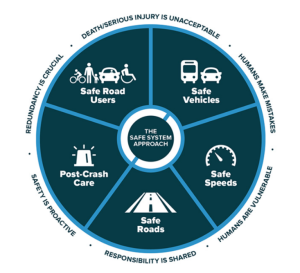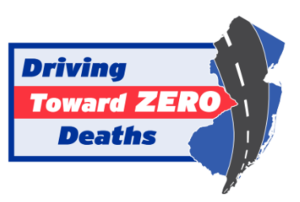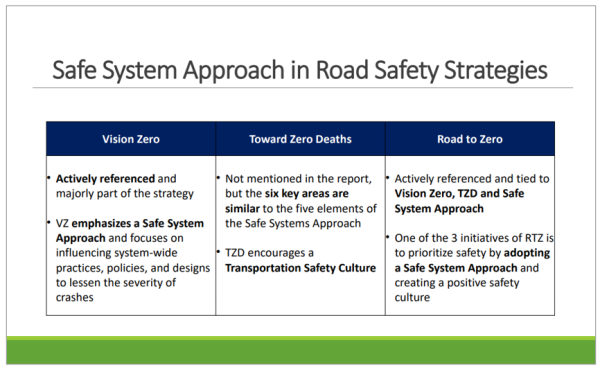With the release of the National Roadway Safety Strategy in 2022, the US Department of Transportation (USDOT) took the first step toward the goal of zero roadway fatalities. USDOT believes that even one fatality or serious injury on the nation’s roadways is unacceptable. This goal of zero roadway deaths was first adopted by Sweden in 1997, after which many countries across the world, including the Netherlands, Australia, and New Zealand, embraced it.

A Zero Deaths initiative is a program that is aimed at reducing the high number of roadway fatalities and serious injuries on US highways, with an eventual goal of eliminating all traffic fatalities. Zero Deaths initiatives are a comprehensive re-thinking of road safety that treats all traffic fatalities and severe injuries as preventable while providing safe, accessible, and equitable transportation options for everyone. Vision Zero, Road to Zero, and Toward Zero Deaths are the three most significant Zero Deaths Initiatives in the US.
The FHWA has endorsed the Safe System Approach (SSA), which is a significant shift in how transportation agencies address roadway safety. SSA is in line with the expanding number of Vision Zero goals, initiatives, and action plans being implemented across the United States. While Vision Zero describes the objective and the Safe System Approach outlines the strategy, both acknowledge that crashes cannot be entirely eliminated. Still, the Safe System Approach asserts that no one should be killed or badly wounded due to a collision while utilizing the road system and that achieving this goal is a shared duty of all parties concerned.

The New Jersey Department of Transportation adopted the Toward Zero Deaths strategy in its 2015 Strategic Highway Safety Plan (SHSP) with a vision to achieve zero deaths on all public roads in New Jersey. The recent NJ SHSP 2020 also referred to the principles and elements of other Zero Deaths initiatives such as Vision Zero and Road to Zero. The New Jersey 2020 SHSP slogan, “Driving Toward Zero Deaths” reflects this shared vision. In New Jersey, cities like Hoboken and Jersey City have adopted Vision Zero plans and are implementing roadway projects to reduce traffic crashes.

In 2022, the New Jersey Bicycle and Pedestrian Resource Center (NJBRPC), funded by NJDOT, researched best practices for integrating the three major Zero Deaths initiatives (Vision Zero, Toward Zero Deaths, and Road to Zero 2050) and the Safe System Approach into statewide transportation planning. The research explores how other states incorporate these approaches into their Strategic Highway Safety Plans (SHSPs) and how it benefits vulnerable road users and ensures transportation equity across the system. While the three initiatives differ in their origins and the makeup of their executive committees, each underscores a commitment to the SSA and support for implementing the FHWA’s proven safety countermeasures.
The review of best practices produced two deliverables: a table and slide deck summarizing the significant characteristics of the three Zero Deaths Initiatives. The table summarizes the differences between Vision Zero, Toward Zero Deaths, and Road to Zero, comparing each initiative’s summary statements, literature published by their executive committees, and application of the principles of the Safe System Approach. It notes that while each initiative subscribes to the Safe System Approach and the FHWA’s proven safety countermeasures, they differ in specific implementation focuses and strategies. The table also compares and contrasts how the three initiatives discuss vulnerable roadway users, addressing speeding drivers, equity, safe system design standards, safety culture, enforcement, and innovative technologies. The slide deck describes the foundational principles of each initiative, including its history, focus areas, and the membership of its steering committee. The slides also explore the FHWA’s Safe System Approach.

Another new NJBPRC resource published for NJDOT is a report called “Addressing Fatal & Serious Injuries through the Safe System Approach: A Literature Review, Case Studies & Findings.” This report examines how the Safe System Approach aims to reduce fatal and serious injuries on roadways in the USA and globally. The report provides an overview of the principles and elements of the Safe System Approach. It also shows that the SSA has proven to be cost-effective, with benefits outweighing expenditures by three to four times. The report further highlights how SSA promotes equity in mobility across the system and benefits pedestrians and bicyclists. As per the National Highway Traffic Safety Administration (NHTSA), pedestrian fatalities in the USA saw a decreasing trend until 2010, after which there was an upward trend. In 2020, pedestrian crashes were up 3.9% which is highest since 1989. Similarly, bicyclist crashes have increased by 9.2%, reaching the highest number since 1987.
New resources on the NJBPRC website also examine and summarize case studies of six states that have updated their SHSPs to better integrate the principles outlined in the Safe System Approach and the three Zero Deaths Initiatives. The case studies compare Massachusetts, Illinois, Florida, Minnesota, New York, and Rhode Island. Each state’s SHSP is examined regarding how it addresses vulnerable road users (specifically pedestrians and bicyclists) and how well its priority areas align with the Safe System Approach.
The new resources will help advocates and professionals understand the differences and similarities between the various Zero Deaths initiatives and discover how other states are implementing these initiatives through their SHSPs. To reach the goals of Vision Zero, we will need to use all of the resources available to us and learn from places where the strategies have already been implemented. These new NJBPRC documents help to make the case that implementing a Safe System Approach or any other Zero Death initiative is achievable and will help us reach our safety goals.
To actively reduce the number of traffic fatalities and serious injuries, the USDOT has asked organizations to join the National Roadway Safety Strategy (NRSS) Call to Action to expand the adoption of Safe System Approach. Join the NRSS Call to Action today and let USDOT know what specific actions you’re taking in 2023 to reduce serious injuries and deaths on our roadways.
FHWA has also released a notice for Request for Information, soliciting comments on what strategies, programmatic adjustments or regulatory changes could help improve safety on U.S. highways. Comments must be received on or before March 20, 2023.
View slide deck on Zero Deaths Initiatives and the Safe System Approach
View comparison table: Zero Deaths Initiatives Table
View our report titled Addressing Fatal and Serious Injuries through the Safe System Approach (2022)
